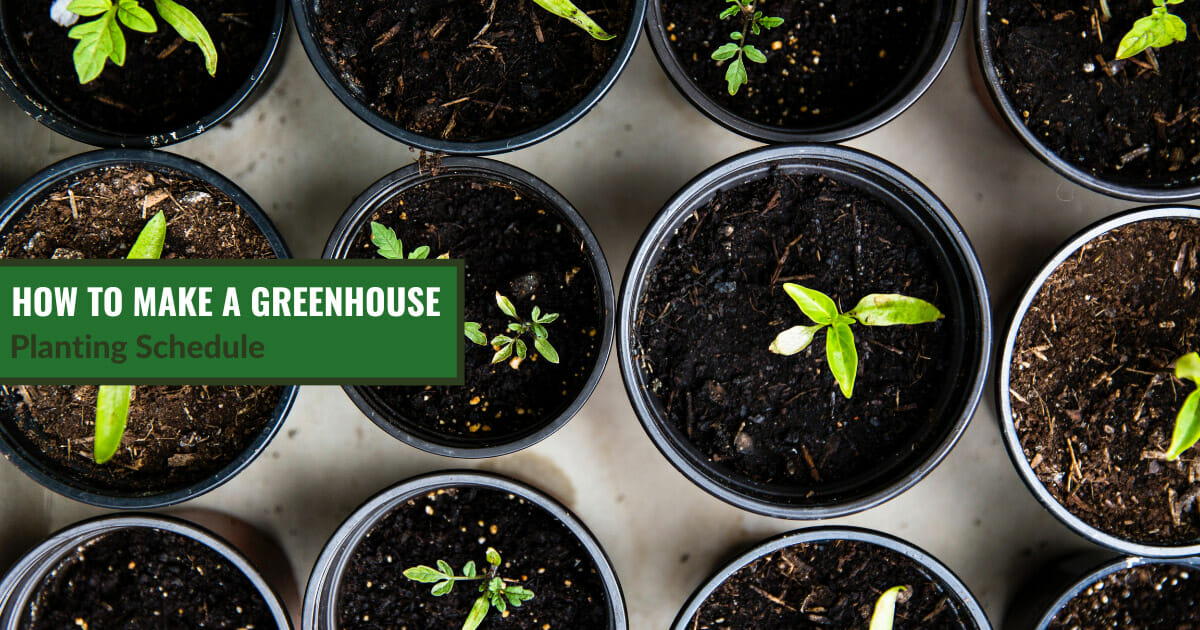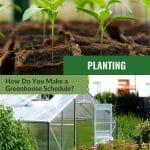
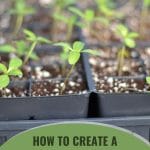

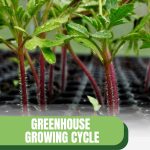
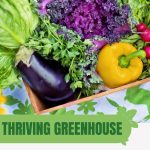



If you want to make the most of your greenhouse, creating a planting schedule is the best way to extend the growing season and grow more crops. If you know what to plant and when, this will help you harvest fresh produce every month, enjoy bigger crop yields, and prevent several gardening problems, such as pests and plant bolting.
The two main factors that determine your planting calendar are light and temperature. Unless you use heaters and grow lights in your greenhouse, you’ll need to plan around them. You’ll also want to incorporate factors such as growing time, yields, and companion planting.
Once you know how to plan out your greenhouse and what to grow, when, you can streamline all of your gardening tasks. Read on to learn more about how to create your personal greenhouse schedule!
Why should you make a greenhouse schedule?
A planting schedule is an important gardening tool because it allows you to envision how to use a greenhouse throughout the year. Not only does it help you face any unforeseen challenges, but it gives you a vision multiple months ahead, instead of just going day-by-day.

Here are some of the main benefits of having a greenhouse planting schedule:
- Helps extend your growing season
- Helps you decide whether to start plants from seeds or from transplants
- Gives long-season crops enough time to grow and ripen
- Prevents issues such as bolting in cool-weather crops
- Makes the most of your greenhouse space and promotes larger harvests
- Ensures a steady supply of fresh fruit and vegetables throughout the year
- Prevents serious pest infestations by planting companion crops at the right time
- Helps you save electricity during the colder months by growing seasonal crops
- Helps you make a return on your investment by using your greenhouse to its full potential
How to create a greenhouse planting schedule
Before you grab a pen and paper and start drawing up your planting calendar, it’s important to understand what you need to do, when, and most importantly, why. Let’s start with the most decisive factors.
Understanding the role of temperature
Temperature plays a crucial role in seed germination and helping plants produce good yields. It also helps you differentiate between the two main types of plants you will grow in your greenhouse: warm-season and cold-season crops.
Warm-season crops need warm soil and warm weather to germinate, and grow best in temperatures around 70-75°F. They also have long growing seasons and can take anywhere between 60 and 120 days to harvest. These include fruiting crops such as tomatoes, eggplants, peppers, cucumbers, corn, beans, melons, and squash.
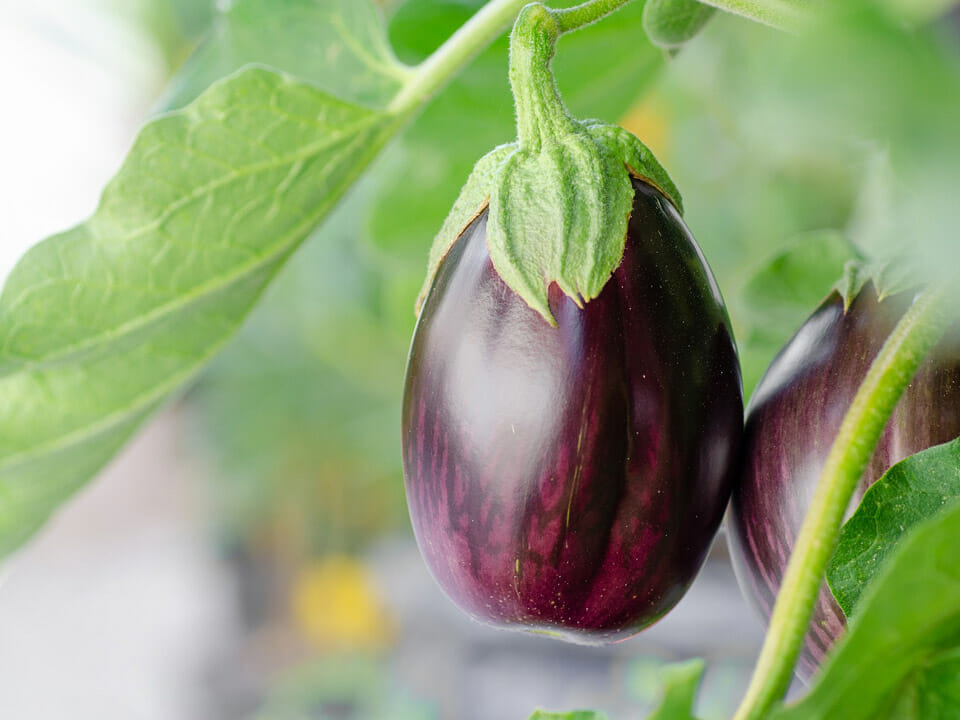
Cool-season crops grow best in temperatures between 50-75°F and will bolt or go to seed once temperatures get too hot. Most are harvested for their leaves, stems, or roots. The list of cool-season vegetables includes plants such as carrots, parsnips, beets, radishes, cabbage, kale, cauliflower, onions, garlic, peas, spinach, and lettuce.
Temperature requirements vary between crops, and what is beneficial to tomatoes and eggplants could be harmful to lettuce and kale. But some requirements are applicable across the board:
- Many seeds need a minimum of 50-60°F to germinate, although some (such as garlic or lettuce) will germinate as low as 32°F. Read more about germination temperatures here.
- Most plants will struggle to grow well in temperatures above 86°F.
- Temperatures above 95°F can cause heat stress even for warm-season plants.
- If you’re planning to grow crops in your greenhouse through the winter, you’ll need to maintain nighttime temperatures above 40°F for cool-season plants or 60°F for warm-season crops.
Keep track of the day length
Light is the main factor that triggers plant growth. Most fruit and vegetables need at least 6-8 hours of direct sunlight per day. They’ll grow vigorously throughout spring and summer, but as winter approaches and the days get shorter, they’ll grow slower even if your greenhouse stays warm enough.
As the day length gets shorter, plants enter a brief period of dormancy. To combat this, you can equip your greenhouse with a set of grow lights. Grow lights allow you to extend your growing season well into the winter months.
Without grow lights, you can still make the most of your greenhouse in the winter. For example, the greenhouse is a good place to get a head start on the spring season by sowing seeds early. You can also sow fast-growing cool-season crops throughout the darker months, such as leafy greens.
Planting from seed vs transplants
A warm greenhouse is a great place to start vegetables from seed. However, growing vegetables from nursery-bought transplants can reduce your growing time by several weeks. For some gardeners, this is a tremendous advantage.
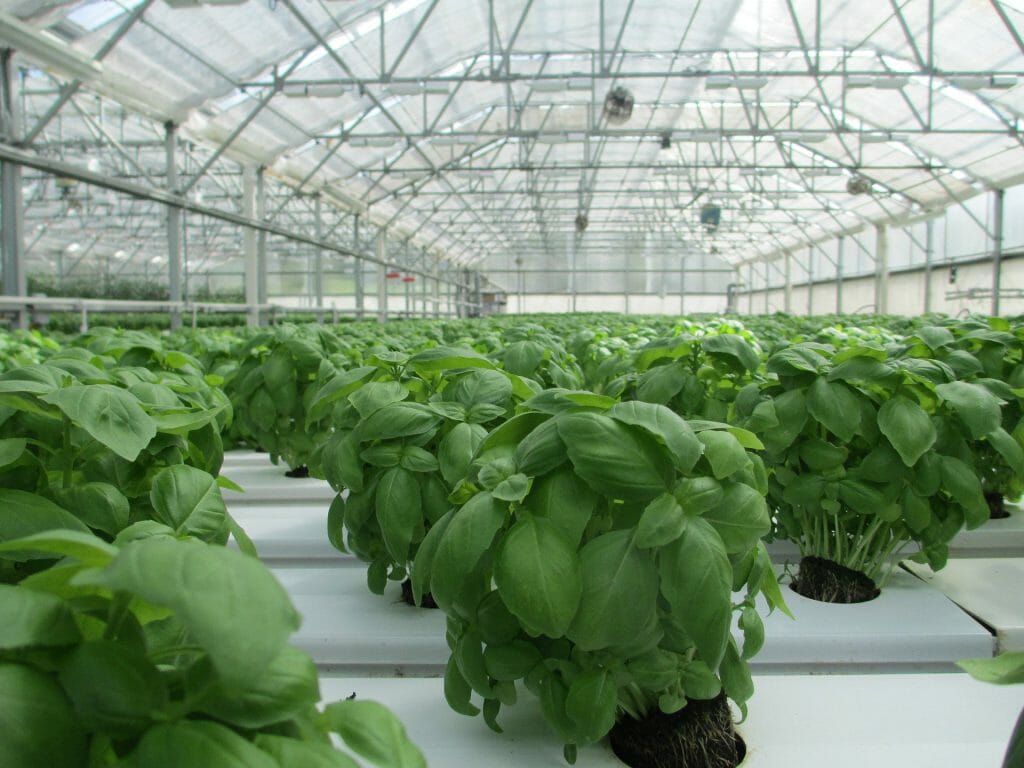
If you live in a cool climate with a short growing season, use transplants to grow heat-loving crops that take a long time to grow, such as tomatoes, eggplants, and pumpkins. Transplants are also the better choice for planting fall and winter crops such as leek, cabbage, broccoli, or Brussels sprouts.
Check how long plants take from seed to harvest
Knowing how long each plant takes to grow will let you know when it’s ready to harvest. But it will also allow you to use your greenhouse space efficiently by squeezing in a few fast-growing crops.
For example, pumpkins and watermelons can easily grow 4 feet wide. However, they’ll take at least a month after planting before they start to sprawl. Rather than letting the space between the plants go to waste during this time, you can use it to grow baby salad greens, which you can harvest in less than 30 days.
The exact time each plant needs to grow from seed to harvest varies depending on the cultivar. Always check the information on the seed packet before planting.
Understand crop yields
Knowing the average yield of each crop helps you decide how much you should plant per person. This will also help you determine if you’ll have enough produce for fresh eating as well as storing.
Here’s a chart with the average yields for 20 common crops, and how much 1 adult needs per year:
| Vegetable | Average yield (lbs) per 100 sq ft | Average need (lbs) per person for fresh use | Average need (lbs) per person for storage |
| Carrot | 70 | 10 | 10 |
| Beet | 60 | 3.5 | 25 |
| Radish | 11 | 4 | N/A |
| Parsnip | 30 | 3 | 3 |
| Lettuce and spinach | 40 | 5 | 5 (frozen spinach) |
| Tomato | 55 | 24 | 36 |
| Bell pepper | 60 | 12 | 18 |
| Cucumber | 50 | 8 | 10 |
| Eggplant | 46 | 4 | 6 |
| Onion | 92 (dry) or 40 (green) | 8 | 20 |
| Garlic | 20 | 1 | 2 |
| Zucchini | 70 | 10 | 3 |
| Pumpkin | 46 | 6 | 3 |
| Snap peas | 32 | 1 | 1 |
| Beans (dry) | 5 | 3 | 3 |
| Potato | 60 | 25 | 75 |
| Cauliflower | 33 | 9 | 12 |
| Brussels sprouts | 12 | 6 | 8 |
| Sweet corn | 36 (ears) | 25 (ears) | 50 (ears) |
Depending on the size of your greenhouse, you can grow enough of a certain crop to have enough left over for winter storage. To learn more about exactly how much you’ll need to grow to give you a certain yield, click here.
Use succession planting
Vegetables such as radishes, spinach, arugula, chard, green onions, and mustard greens take 30-50 days to grow from seed. They’re also best eaten fresh and don’t require a lot of growing space. To ensure a steady supply of fresh salad greens, sow a new batch of seeds every couple of weeks throughout mid winter and spring, then repeat the sowing from late summer until mid fall.

You can also harvest some vegetables before they’re fully grown, including onions, carrots, and fennel. Pick some of the immature plants, let the others reach full size, and sow more seeds in between them for continual harvests.
Leave room for companion plants
Garden pests are active from late spring until late summer. This is the time when your leafy vegetables are in their prime, and fruiting crops are busy flowering and setting fruit.
If you don’t want to see all your hard work go to waste, make sure to leave room in your planting calendar for companion plants. Try sowing them as early as possible, so that they have enough time to grow before garden pests become a nuisance.
Only grow the plants you like to eat
It’s tempting to use your greenhouse to grow superfoods such as kale, artichokes, kohlrabi, and brussels sprouts, or exotic crops like guava and bitter melon. But if you or your family don’t like eating them, planting these crops is counterproductive.
Instead, it’s better to use your limited space and resources for crowd-pleasers such as potatoes, tomatoes, and strawberries, or vegetables you can use in many different recipes, such as onions and garlic.
Monthly greenhouse planting calendar
Now that you have a better understanding of why it’s important to create a planting calendar, it’s time to make one! Design your greenhouse growing schedule according to your local climate while also paying attention to your needs and wants.
To start, note down your overall priorities, then lay out what to plant and when so you can be ready to tackle the next growing season. To help you get started, we’ve broken down the year on a month-by-month basis, which you can adjust for your growing zone as needed.
Winter
Winter is arguably the most difficult season for successful greenhouse growing. Unless you’re supplementing with heat and light, you may only be able to grow certain cold-season crops such as leafy greens, use the greenhouse as an overwintering station, or simply get a headstart on the spring season.
December
The last month of the calendar year is usually a slow month when it comes to planting. You’ll probably be busy harvesting the last of your fall crops, such as kale, cabbage, leeks, and carrots. Or maybe you’re growing microgreens or cold-tolerant lettuces to get you through the winter.

Use this month to browse seed catalogs and decide what to plant in the following weeks and months. Before you buy new seeds, make a list of what crops you want to grow and where you’ll be planting them. This little bit of extra work will go a long way towards streamlining the growing season!
January
Depending on your planting zone, January marks the start of the planting season for certain hardy vegetables that take between 30 and 60 days to harvest. For example, you can begin sowing spinach, bok choy, mustard greens, kale, carrots, peas, and beets.
If you’re growing onions from seeds, this is a good month to plant them. You can also start chitting first-early and second-early seed potatoes.
February
In February, prepare your greenhouse for plants that need lots of light and warmth, and vegetables with a long growing season. Sow tomatoes, eggplants, peppers, pumpkins, broccoli, cauliflower, and any other crops that need 90 – 120 days from seed to harvest.

If your greenhouse is still cold, keep the seed trays on heat mats to speed up germination. Plant your sprouted seed potatoes in a bag of soil.
Spring
As the days get longer, there’s more and more work to be done in the greenhouse. But at this point you’re probably well-rested and ready to get a head start on the summer! Here are some general guidelines for your greenhouse planting schedule:
March
By March, the vegetables you planted in winter should be ready for picking. Harvest your salad greens, radishes, and beets. Sow zucchini, beans, leeks, and cucumbers in propagation trays. If you have the space, use it for crops that take 4-6 weeks to grow, such as arugula, chard, spinach, or radishes. Pick a maincrop potato variety, and start chitting the seed potatoes.
April
April is a busy month for the greenhouse gardener, with the days getting longer and warmer. If your maincrop potatoes have sprouted, plant them in a grow bag. Plant sweet potato slips, sweet corn, sunflowers, and herbs such as basil, cilantro, parsley, and oregano.

Start transplanting crops such as tomatoes, peppers, eggplants, and pumpkins into larger containers. Now is also a good time to sow companion plants that will protect your crops from pests in the summer, such as nasturtiums, marigolds, hardy geraniums, or petunias.
May
In May, your focus should shift to summer crops and long-season vegetables. Harvest the last of your greenhouse-grown kale, spinach, carrots, peas, and lettuce. Transplant cool-season plants such as potatoes, broccoli, cauliflower, and Brussels sprouts to the outdoor garden to make room for the heat-loving plants.
Your early and second-early potatoes should also be ready for picking by now. Fruiting crops such as tomatoes, peppers, eggplants, pumpkins, and cucumbers will start flowering around this time and will need to be pollinated. You can do this by adding a fan or opening the greenhouse door to pollinators.
Summer
Long warm days result in a lot of rapid growth, which in turn translates to work for the greenhouse garden. In this season, it’s important to stay on top of planting, trimming, and harvesting to make the most of the space in your greenhouse.
If your climate gets particularly warm during this time, you may need to take extra measures to make sure your greenhouse does not overheat.
June
June is all about helping your fruit and vegetables thrive. Most of your crops will keep you busy with regular pruning, watering, fertilizing, pollinating, and keeping an eye out for pests and diseases. If you have the time and space, you can squeeze in some heat-tolerant salad greens such as New Zealand spinach, arugula, and bolt-resistant lettuce varieties.
July
July will keep you busy with many of the same tasks. As temperatures soar, you’ll need to pay close attention to regulating the humidity, providing ventilation, and preventing overheating. On the plus side, you should be able to start harvesting crops such as beans, cucumbers, zucchini, and cherry tomatoes!
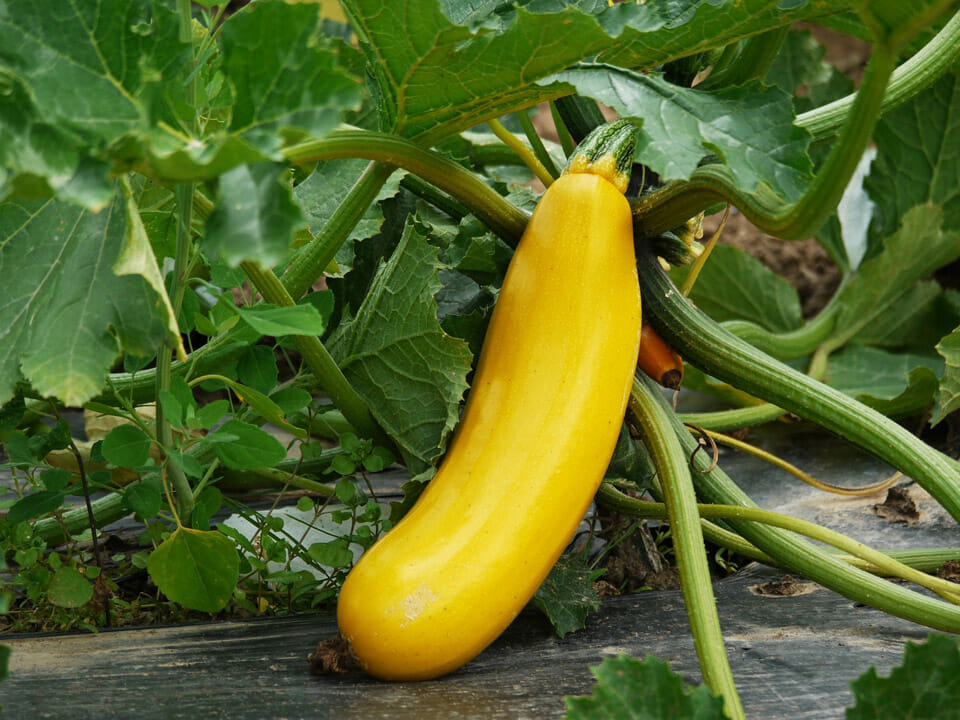
August
August is by far the busiest month of the year in the garden. Most of your summer crops will be ready for picking, and you’ll also need to start thinking about what to grow for fall and winter.
Now is an excellent time to plant vegetables that need warm temperatures in the first half of their growing cycle, and cooler temperatures in the second half. Use propagation trays to sow Brassicas such as cabbage, cauliflower, broccoli, and Brussels sprouts.
Fall
Are you starting to see the benefits of having a greenhouse garden schedule? As the summer nears an end, you’ll likely still be busy with many of the long-season crops. Tomatoes and peppers especially can keep providing fruit for months if the climate allows.
But if you want to make the most of the fall in your greenhouse, you’ll need to start shifting towards short, cool-season crops again by clearing room and sowing new seeds.
September
Greenhouse tasks in September are similar to those of August. Harvest your tomatoes, peppers, eggplants, squash, and maincrop potatoes. Transplant your Brassica seedlings into larger containers, and start sowing vegetables for your winter garden, such as bok choy, parsnip, kale, turnips, and spinach.
If you want a crop of new potatoes ready by winter, now is the time to plant some early and second-early maturing varieties. Last but not least, this is the best month to plant crops that benefit from overwintering, such as garlic and strawberries.
October
By October, the days will start getting noticeably shorter, and your planting schedule will start to wind down. Harvest and cure your pumpkins and winter squashes, and pick the last of your sweet and maincrop potatoes. Use the space you’ve freed up to plant some quick-growing crops, and to overwinter potted fruit trees and herbs.

If you’re growing onions from bulbs or sets, this is your last call to plant them. October is also a great month to inspect your greenhouse and make sure everything is ready for the cooler months.
November
November tends to be a quiet month. You can use this spare time to finish tidying up your greenhouse and prepare it for overwintering your crops. Check the thermometer and turn on the heaters if nighttime temperatures drop below 50°F. Use straw and mulch to insulate your garlic, strawberries, and onions.
Unless you use grow lights, the growth rate of your plants will slow down as they enter a period of ‘hibernation’. However, you can still use your greenhouse to grow microgreens, especially if daytime temperatures remain around 70°F.
Remember to give yourself time to rest. Creating a planting calendar and using staggered planting to keep yourself busy is great, but every gardener needs a moment to catch their breath. Use this time of year to kick back, unwind, and enjoy the fruit (and veg) of your hard labor.

